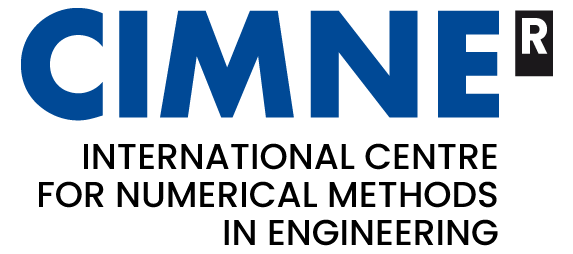Dust in Barcelona
Developing a modeling framework to support the monitoring of the pollutants in large urban areas and produce short-term forecasts for mitigating the health risks.
In a nutshell
- Large cities are particularly affected by high levels of such air pollutants as PM2.5, PM10, black carbon, dust, aerosol deriving both from human activities and natural events. The use case aims to provide a modeling framework for monitoring the pollutants movement in large urban areas.
- The proposed modeling methodology estimates the wind speed and direction, as well as how the pollutants are being transported on the urban streets.
- As a result, it is expected to obtain high resolution short-term forecasts of the pollutants movement in complex urban environment. This technology would enable policy-makers and institutions to mitigate the consequences of pollution events and plan for “what if” scenarios to protect the population wellbeing.
Technical Overview
Challenge
Over 75% of citizens in urban areas are exposed to levels of pollution above the limits established by the World Health Organization, making air pollution an environmental issue of public interest. Several pollutants can be found in cities. However, as many studies indicate, particulate air pollutants (PM2.5, PM10, black carbon, dust, aerosols, etc.) can have a direct negative effect on health. Such particulate air pollutants are composed of a number of solid and liquid substances, which can be derived both from human activities such as: road traffic, industrial processes and construction works, and from natural sources such as dust storms, volcanic eruptions and forest fires.
The use case objective is to implement a numerical framework for modeling the transport of PM10 or other suspended particles at the street level, covering large urban areas. The numerical model runs on DEDL’s infrastructure and uses its framework to connect to various sources of federated data. This use case is executed in the urban environment of the city of Barcelona, which is a good study area given the concentration of pollution sources.
The use case “Dust in Barcelona” was first conceptualized at the Destination Earth User Workshop held in Darmstadt (DE) in July 2023 by EUMETSAT. The goal was to define use cases to test the Data Lake’s infrastructure, with practical cases that could be later included as DestinE service offerings.
DestinE Solution
The modeling methodology consists of two main steps:
1. Estimate the wind speed and direction over the streets of the urban area
The first step is to calculate the velocity vectors of the wind flow at 10 m height. In order to obtain a fast and robust estimate of the velocity field, we ignore the vorticity and turbulence effects and solve the potential flow equation for an incompressible flow. We make use of the meso-scale wind prediction from the digital twin (Climate Adaptation or Weather Extremes) and prescribe the wind speed and direction at the far field boundary of the urban area (see Figure 1).
Since we are interested in calculating the concentration of the PM10 particles at the surface level (3.5 m), we assume a theoretical wind vertical profile.
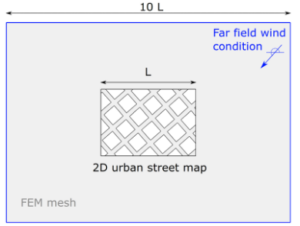
Next, we interpolate the PM10 concentrations obtained by the CAMS forecast at the FEM mesh (Figure 2) and transport the pollutant over the streets of the urban area using the previously estimated wind velocity at 3.5 m height. In order to do so, the advection-diffusion-absorption transport equation is solved using a semi-Lagrangian strategy of two steps.
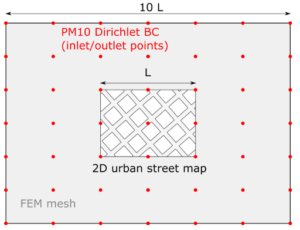
The modeling core is a finite element method (FEM) application of Kratos Multiphysics (Kratos) (https://github.com/KratosMultiphysics), specifically designed for the current use case. Kratos is an Open-Source framework for building parallel multidisciplinary simulation software. Modularity, extensibility and High-Performance Computing (HPC) are some of its main features. Kratos has a Berkeley Software Distribution (BSD) license and is written in C++ with an extensive Python interface.
The mesh of the city of Barcelona to perform the computations was provided by CIMNE and is a high detail mesh of the city of Barcelona with over one million triangles (see Figure 3).
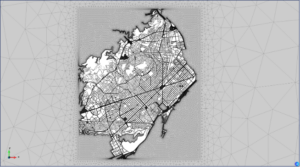
The Islet service was used to setup a virtual machine which hosts all the use case functionality. An additional service from Islet was an S3 storage bucket, which was connected to the VM via a mount point and functioned as a directory; as the total amount of data to be used could grow beyond that allocated for the VM alone.
The Harmonized Data Access (HDA) API which accesses the STAC metadata for each dataset on the DEDL offers the most rapid way to obtain the required information. This service was used via PyStac/Python scripts. This was the simple and direct way to find and obtain the data and store it in the S3 bucket.
Additional Python scripts are used to execute the calculations. Figure 4 depicts a schema of the Architecture used in this use case.
The results are visualized and analyzed using GiD’s post-processing tools (Figures 5, 6 and 7). GiD Simulation (https://www.gidsimulation.com/) is a universal Pre & Post Processor for numerical simulations and it is also installed in the Islet virtual machine.
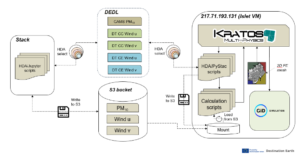
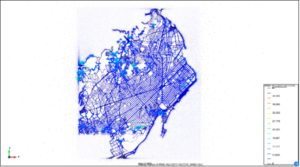
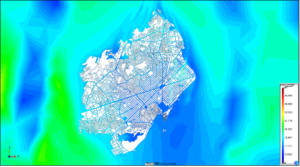
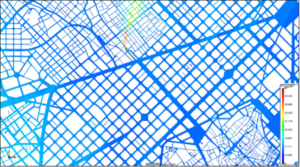
Impact
The Dust in Barcelona use case aims at providing high resolution short term forecasts (72 hours) of the dust and particulate air pollutants in a complex urban environment such as the city of Barcelona. These forecasts enable institutions and policy makers to enact measures that mitigate the effects of pollution events which exceed recommended limits. The use case also provides a tool to plan for “what if” scenarios. Enabling policy makers to rehearse in the digital twin the effectiveness of different mitigation strategies ahead of their occurrence. Possible strategies that could be evaluated are traffic restrictions, forced closures of polluting industrial activities, or in more extreme cases, recommendations for the population at large to seclude indoors.
The long term impact of the use of this use case would be a notable reduction of premature deaths and respiratory diseases in the population.
Contributions
Providers
